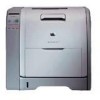HP 3500 HP Color LaserJet 3500 Series Printer - Software Technical Reference, - Page 208
HP Color LaserJet 3500 custom paper sizes, Print server operating system migration - color laserjet parts
 |
View all HP 3500 manuals
Add to My Manuals
Save this manual to your list of manuals |
Page 208 highlights
HP Color LaserJet 3500 custom paper sizes Note The PS driver does not support user-defined media sizes. The following table shows custom paper sizes that are available for the HP Color LaserJet 9500 series printers. Table 83: HP Color LaserJet 3500 custom paper sizes Tray Dimensions Minimum Tray 1 Width 98 mm (3.9 inches) Height 191 mm (7.5 inches) Tray 2 (500-sheet) Width 148 mm (5.8 inches) Height 210 mm (8.2 inches) Tray 3 (500-sheet) Width 148 mm (5.8 inches) Height 210 mm (8.2 inches) Maximum 306 mm (12.0 inches) 469 (18.50 inches) 296 mm (11.69 inches) 432 mm (17.0 inches) 297 mm (11.7 inches) 432 mm (17.0 inches) Print server operating system migration The large installed base of printers and print servers in corporate environments, combined with the large user-base for these printers, implies that an operating system migration takes an extended period of time, often months or even years, to complete. Because of this, it is unavoidable that the corporate environment ends up operating with a mix of Windows NT 4.0 and newer operating systems (Windows 2000, Windows XP and Windows Server 2003) for an extended period of time. A number of printer driver issues related to operating in a mixed-OS environment must be considered when planning a print server operating system migration from Windows NT 4.0 to Windows 2000 or later. This section explores these issues and outlines several strategies that HP recommends to support a mixed OS environment with respect to printer drivers. This discussion is not intended to make specific procedural recommendations for executing a print server OS migration. This discussion is intended to help system administrators and IT managers understand the printer driver issues related to operating in a mixed-OS environment so that the requirements resulting from the recommendations outlined in this document can be factored into migration planning. The topics discussed here apply to IT environments that are currently running Windows NT 4.0 on the print servers and clients, and are migrating to future operating systems for both print servers and clients. The Windows 9x family of operating systems is not discussed in this document because Windows 9x clients can be supported with Point and Print equally well from any server platform. A basic working knowledge of shared printing through Microsoft Windows Point and Print is assumed. While much of this discussion is general in nature, all of the specific driver recommendations in this document apply to HP LaserJet and Business InkJet printers and printer drivers. Background information and terminology Version 2 driver With Windows NT 4.0, printer drivers were considered, generally, to be a class of graphics drivers. Due to the performance requirements of some types of graphics drivers, like display drivers, these drivers executed in kernel mode. A kernel mode process runs in a specially privileged part of the operating system that gives the process access to all of the system resources. Due to the nature of the privileges granted to kernel mode processes, a misbehaving driver can cause serious system stability problems, including operating system crashes. Microsoft refers to these kernel mode printer drivers as Version-2 drivers and this is the term used throughout this section. 206 Print server operating system migration Software Technical Reference ENWW















